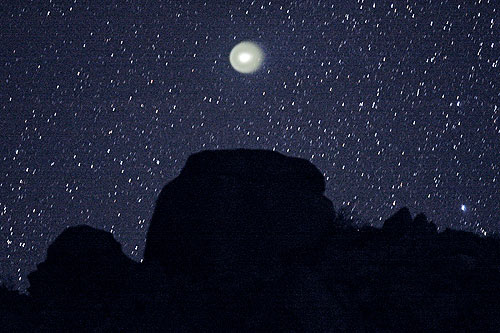tags: comet holmes, night sky, astronomy
Comet Holmes rises in the northeastern sky above Coyote Canyon in Anza Borrego Desert State Park, California. It's visible to the naked eye and better seen with binoculars. Discovered in the late 19th Century, Holmes has become dramatically brighter in the past 2 weeks.
Image: Don Bartletti (Los Angeles Times).
I just learned about the amazing Comet Homes, which has unexpectedly brightened more than one million times literally overnight, its appearance changing from that of a normal comet with a tail into a brilliant, tailless puffball in the night sky.
Even though this is the first time any living person has witnessed such a spectacle, this unusual comet has provided similar celestial thrills before; in November 1892, this comet also erupted and brightened noticably, which might be the reason that amateur astronomer Edwin Holmes first saw it.
Interestingly,2.5 months later, in early 1893, this comet underwent a second eruption and subsequent brightening. What is happening to cause this comet show such bizarre changes? Was it hit by a meteor, or does it have an irregular body, like a piece of swiss cheese flying through the vacuum of space?
The best thing about Comet Holmes is that it is easily visible with the naked eye (although astronomers recommend that you use binoculars to see it better) in the northeastern sky -- even if the sky isn't completely dark, as is the case for NYC, and other cities on the eastern seaboard.
So when you are out tonight, make a point to look heavenward. What you see will surprise and delight you.
See Comet Holmes' orbit trajectory through our solar system.
LATimes (image).


Any chance of seeing it in Sitka, Alaska?
(tis where i be)
Unless of course it's pouring rain - but I'm not really complaining because we surely do need it.
You should be able to see it in Sitka, as the comet is in the constellation Perseus, which is well above the celestial equator. The Sky and Telescope link above should guide you; if not, try earthsky.com or search on "comet holmes". Look soon, as it is spreading, which makes it fuzzier. It is also getting dimmer overall. The photo above does not reflect the visual appearance (for various photographic and photo image reasons). The comet is now noticably dimmer than the brightest of the nearby stars.
Great news! you article was accepted for our Natural Science Carnival! Visit the Carnival here and don't forget to comment, link back, spread the word!